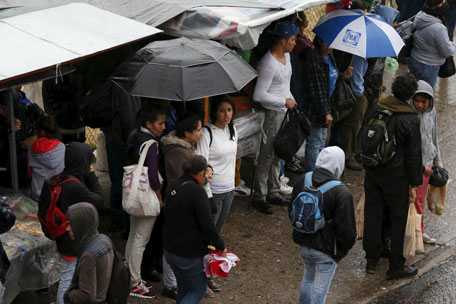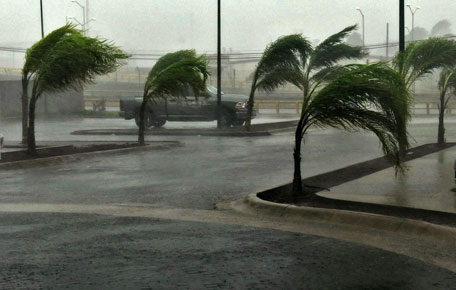Latest: Hurricane Patricia caused less damage than feared so far after making landfall on Mexico's Pacific coast, President Enrique Pena Nieto said, warning that it still posed a threat.
Record-breaking Hurricane Patricia crashed into Mexico's Pacific coast on Friday, uprooting trees, dumping heavy rain and generating fears that its powerful winds will leave a trail of destruction.
Authorities relocated coastal residents, evacuated tourists from beach hotels and closed sea ports, airports and schools in several states before the category five hurricane made landfall in the western state of Jalisco.
The hurricane crashed ashore in the town of Emiliano Zapata, about 95 kilometers (60 miles) west of the major port of Manzanillo, National Water Commission director Roberto Ramirez told Milenio television.
Pic courtesy: Fox News @ Twitter
The US National Hurricane Center said Patricia weakened marginally at landfall at 2315 GMT, with maximum winds of 270 kilometers per hour that came down to 260 kph as the hurricane moved further inland.
Patricia peaked at 325 kilometers per hour several hours earlier -- more powerful than the 315 kph winds of Super Typhoon Haiyan, which left more than 7,350 dead or missing when it struck the Philippines in November 2013.
Rain and wind lashed the coast hours after Patricia mushroomed late Thursday into a category five storm -- the top of the Saffir-Simpson scale.
"We are facing a natural phenomenon, a force that we have never seen before" in the world, President Enrique Pena Nieto told Radio Formula earlier in the day. "We will face difficult moments."
There were no immediate reports of casualties.
In the state of Colima, where Manzanillo lies, some 350 trees ripped out of the ground "but fortunately there is only material damage," Agriculture Minister Jose Calzada told Milenio television.
 View of the street during the arrival of hurricane Patricia.(AFP)
View of the street during the arrival of hurricane Patricia.(AFP)
'Wrong place, wrong time'
Stores shut down in the tourist resort of Puerto Vallarta, farther north of where Patricia made landfall, and shop owners attached duct tape to their windows for protection.
Some 7,000 foreign and 21,000 Mexican tourists were in Puerto Vallarta ahead of the storm.
Seafront hotels were evacuated and several tourists were rushed to shelters, the airport and bus stations.
Federal officials said 3,500 people were evacuated from Puerto Vallarta by bus and plane.
A Red Cross facility turned into a shelter for 109 people in Puerto Vallarta, including Americans, Canadians and Italians.
"I had the bad luck of being at the wrong place in the wrong time," said Gian Paolo Azzena, a 26-year-old Italian medical school graduate. "I found out that a hurricane was coming thanks to a craftsman. I thought it was a joke."
A handful of people waited at a bus station before service ended at midday, while others bought water and loaded vehicles with jerrycans of fuel.
 Residents shelter from the rain outside a bus station in Guadalajara. (AFP)
Residents shelter from the rain outside a bus station in Guadalajara. (AFP)
But by late evening, the resort appeared to have been spared by Patricia, which US forecasters said was expected to rapidly weaken over the mountains and dissipate on Saturday.
Some 20 people were even seen drinking at a beach bar earlier in the afternoon.
President Barack Obama said US disaster aid experts were on the ground and primed to help.
Tens of thousands of US tourists are among those in the hurricane's path, US officials said.
US bound?
Authorities shut down power along the coasts of Jalisco and Colima states to prevent electrocutions.
Jose Maria Tapia Franco, director of the National Disaster Fund, said 400,000 people live in vulnerable areas. Hundreds of shelters were made available.
 View of a street in Manzanillo, Colima state, Mexico on
View of a street in Manzanillo, Colima state, Mexico on
In Colima, villages around the Volcano of Fire were emptied over concerns that ash that accumulated during recent volcanic activity could combine with water to produce landslides.
Authorities deployed 400 federal police to assist populations in the area.
Patricia is expected to dump up to 20 inches (51 centimeters) of rain over five western Mexican states, which could trigger life-threatening flash floods and mudslides.
The National Water Commission said Patricia was "so big and intense" that it could cross the entire country, dip into the Gulf of Mexico, and make landfall in the United States.
Jalisco, Michoacan, Colima and Nayarit states are expected to get the equivalent of 40 per cent of their annual rainfall in the next 48 hours, the water commission said.
Mexico faces the double threat of Atlantic and Pacific tropical storms during the hurricane season, which ends November 30.